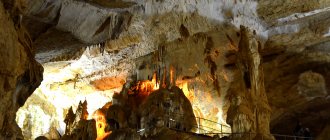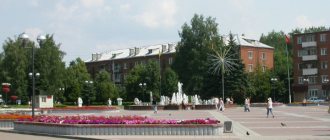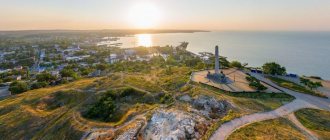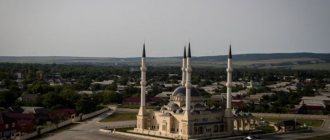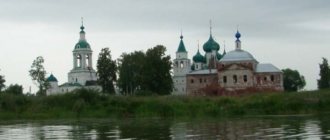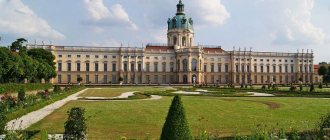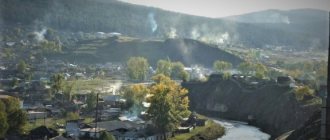Most people associate Tula with gingerbread, a samovar and a savvy flea. Some people remember Yasnaya Polyana and the Museum of Weapons.
Don't be the majority, discover Tula for real. After all, the city has its own university, necropolis, and depot museum. And this is only a small part of the interesting places; no less of them are collected around Tula.
You need to spend several days in Tula to see everything and go to all the museums. Especially if you want to visit all the attractions not only in the city itself, but also in its surroundings - Kulikovo Field, Yasnaya Polyana and more. But if you only have one or two days, our list will help you choose the most interesting.
What is the best way to get to Tula - by train, bus or car?
The most interesting things around Tula are in the overview of the sights of the Tula region.
A city with character
Modern Tula cannot be called a metropolis of the new century. Despite the abundance of industrial enterprises in the city, it does not at all look like a technological center looking to the future. Everything here is quiet, simple and modest, despite the fact that the city has something to boast about.
It has more than enough tourism potential, but little ambition. Such is the character of the Tula people, who from time immemorial are accustomed to doing business, and not playing tricks. Tula is the homeland of skilled blacksmiths, capable of shoeing a flea and making a gun for the army. And in calm, peaceful times, you can surprise with samovars, and ones that even today you just want to put on the table. The city is sincerely proud of its long history and, it seems, does not want to change anything at all: not in its architectural appearance, which was seriously damaged during Soviet times. Not out of habit: paying tribute to the past, Tula remains the original spiritual center of Russia, where it’s nice to come for a day or two to immerse yourself in this amazing atmosphere.
The spirit of history can be seen in the historical center of the city, which, according to various sources, was founded either in the 12th century or in the 16th century. The first version is supported by evidence from chronicles in which Tula is mentioned in 1146. If we count from this date, then the city is already nine centuries old, which means it is included in the cohort of the oldest Russian cities. Founded as a fortress designed to protect the borders of Rus' from the attacks of the Crimean Tatars, it has preserved both ancient and spiritual fortifications: there are many ancient temples and churches.
How to get to Tula
The city is located 173 km from Moscow. This means that you can go here from the capital by car: the road will not be tiring. Your own transport opens up additional opportunities to explore not only the city, but also its surroundings, which are no less interesting than Tula itself.
There are also high-speed trains from the capital in this direction. Travel time takes 2-3 hours. If you get from St. Petersburg, the distance will be longer - 900 km, so you need to plan half a day for a trip by train or car.
The city itself has a developed transport network: you can get around by minibuses or trams. But if you are strictly interested in the sights of Tula, you won’t have to go anywhere. All the most valuable, interesting and historical things are concentrated within the city center, where it is most convenient to walk without rushing anywhere.
Kazanskaya embankment
There is also a sense of connection between times here. The embankment seamlessly combines modern buildings and buildings that have survived centuries.
The street is conducive to walking. If you wish, you can take a boat ride.
Kazanskaya embankment
A day spent in Tula will give you a lot of impressions, emotions and a desire to return here again and again.
You can learn more about what to see in Tula in 1 day by watching the video:
What to see in Tula in 1 day on your own
The city is exceptionally good because it is easy to get around without a guide. You won't be able to get lost or miss something important, even if you want to. Everything here is close and compact, and one starts getting acquainted with the city, of course, from the Kremlin.
The Tula Kremlin is a perfectly preserved 16th-century building that differs from its counterparts in other ancient cities. The Tula Kremlin was not built in a hurry before an enemy raid, but in a balanced, thoughtful manner, according to a regular plan. Therefore, it is absolutely logical, regular rectangular in shape, neat both inside and outside.
Its high red brick walls are crowned with turrets and battlements in the shape of a swallowtail. Historians believe that Italian craftsmen were involved in the construction, who gave the defensive structure an elegance uncharacteristic of the 16th century. Another difference is that it is located not on a hill, but in a lowland, so you won’t be able to contemplate the surroundings from the fortress wall. But you can devote time to exploring what is within the walls of the fortress. And here are powerful towers, two of which house museums, and the oldest Tula churches.
Assumption Cathedral . This is a majestic building from the 18th century, located on the territory of the Kremlin. You need to enjoy its appearance from afar in order to see it in its entirety. It is worth taking in the light walls, the gilded domes, and the rich decor with elaborate bas-reliefs and ornaments. It’s amazing how an Orthodox church can so closely resemble either an elegant box or a fairy-tale palace. Nevertheless, this is the current and main temple of the local diocese and one of the main historical sites of Tula. It is impossible not to notice that the cathedral is in perfect condition. It is beautifully restored and is perceived as the heart of the Tula Kremlin.
pixabay.com/
Epiphany Cathedral . This ancient building is also located in the Tula Kremlin and is also included in the cohort of interesting places in Tula and the region. Built at the beginning of the 19th century, it was not used for its intended purpose for long. In Soviet times, the Orthodox church was turned into either a palace for athletes or a flying club. The building was mercilessly rebuilt, thereby changing its original appearance beyond recognition. In the 70s, they decided to place a weapons museum here, and to this day, part of the famous exhibition is located in the already restored cathedral.
Elegant shopping arcades built in the 19th century have also been preserved on the territory of the Kremlin. And the first city power plant, which does not fit into the appearance of the complex at all. To explore all this, you will need at least four to five hours, and only then you can go for a walk along the city streets.
Not far from the Kremlin there are other interesting ancient buildings. This is the Church of the Annunciation, which is barely younger than the Kremlin walls and is a functioning temple. These are two nearby churches of the Assumption Convent, the view of which you can admire and go further to the Nikolo-Zaretsky Church . Its architecture may not surprise you, but its purpose is unusual for Russian cultural traditions. The temple was built by the famous Tula dynasty of industrialists, the Demidovs, as a necropolis. And today it serves as a tomb for several generations of a once rich and powerful family.
Historical and architectural monuments
While walking around the flourishing city, whose history goes back centuries, there will undoubtedly be something for connoisseurs of grace and beauty to see. An excursion to the colorful monuments and architectural sights of Tula will bring many vivid emotions.
Estate of I. Liventsov
- Address: st. Dzerzhinsky, 15/7. Transport stop "Dzerzhinsky Street".
Mayor I.V. Liventsov, who owned a luxurious estate built at the turn of the 18th and 19th centuries, bequeathed it to Thule after his death. A stunningly beautiful building with a dome, a lush façade decoration, in the niches of which antique sculptures were placed, was the main architectural pearl of the city of those years. You could enter the estate through the front gate, the arches of which were supported by Doric columns facing Pochtovaya Street, or from Denisovsky Lane, through an equally elegant entrance with attics. Unfortunately, today we can admire only a small part of its former splendor. The main building of the estate, which is in good condition, houses the Children's Art House, but the gates have become dilapidated and are gradually being destroyed. But even in their current form they remain remarkable architectural monuments.
Pyatnitsky Gate Tower
- Address: Entrance to the Kremlin from Metallistov Street. Transport stop "Lenin Square".
One of the most elegant towers of the Tula Kremlin, rising above the swallowtails of the battlements of the fortress wall, protected the entrance to the city from the northwestern side. A square fortification with loopholes is covered by a hipped dome, above which rises another elegant turret, topped with a weather vane. For almost 200 years, royal motorcades, high clergy with their retinue, overseas ambassadors and other honored guests of Tula entered through the gate at the base of the tower, which was then considered a ceremonial gate.
Monument to Lefty
- Address: st. Soviet. Transport stop "Mosina Street".
The bronze monument to the literary hero - the magnificent master Levsha, who, having shown extraordinary talent and Russian ingenuity, managed to outdo the prim English mechanics, was installed on the territory of the Tulmashzavod back in 1989, and 20 years later it took its current place in the city center. A folk craftsman in a blacksmith's apron holds a hammer in one hand and the same flea in the other, as if assessing whether the famous horseshoes fit it. Many Tula residents believe that the prototype of Lefty was A. M. Surnin, who worked for many years at an arms factory and was then appointed its chief mechanic by personal decree of Catherine the Great.
Monument to Peter I
- Address: st. Soviet. Transport stop "Metallistov Street".
The monument to the first Russian emperor was erected in front of one of the brainchildren of Peter I - the Tula Arms Factory. It is interesting that the bronze statue of the Tsar-Reformer, created by the sculptor R. Bach in 1912 for the 200th anniversary of the enterprise, was on the territory of TOZ for a long time and only in 1962 was it put on public display in front of the plant management building. According to the author's plan, Peter the Great appears not as a monarch, but as a simple artisan, not afraid of the hardest work, purposeful, confident in his skill. You will not see such an embodiment of the image of the great emperor anywhere else.
Monument to Leo Tolstoy
- Address: Tolstoy Square. Transport stop "Ulitsa Zhavoronkova".
As you know, the famous Russian writer, whose works are included in the golden fund of world literature, was born in the Tula province. Therefore, there simply could not be a monument to him in the regional center. The monument to the classic appeared in a cozy park with a fountain on Lenin Avenue for a significant date - the 145th anniversary of the birth of L.N. Tolstova. A six-meter bronze sculpture on a massive pedestal trimmed with polished granite depicts the great writer walking through his native land, glorified with inexpressible warmth in many of Lev Nikolaevich’s works.
Sculptural composition “At the samovar”
- Address: Intersection of Puzakova and Oktyabrskaya streets. Transport stop "Moskovskaya Zastava".
In the homeland of Russian samovars there are several monuments dedicated to one of the symbols of Tula. The most beloved by local residents and popular among tourists is the elegant sculpture that greets city guests entering it from Moscow. The composition, cast in bronze, depicts a tea party at a festive table, on which stands a magnificent samovar. A charming city woman listens to the melodic sounds of an accordion played by her friend. A cat and a dog are nestled at the feet of the couple, and Tula gingerbread flaunts between the cups on the table. The free chair and third cup are clearly meant for you. The sculpture seems to emanate peace and warmth.
Don't miss: The most interesting places in Tula region
Sights of Tula - what to see in a couple of days
If time permits, do not pass by the original building, built in the shape of a hero’s helmet. It is located next to the Nikolo-Zaretsky Church. This unusual building houses one of the main tourist sites of Tula, its pride and true historical value - the Tula Weapons Museum .
Approaching it, you are surprised by the impeccable surrounding cleanliness and order. It is noticeable that Tula residents value and honor the weapons traditions of their city. The museum’s collection is not only the largest in Russia, but also the oldest: the order for its creation was issued personally by Peter I. And by decree of Empress Catherine II, the Chamber of Rare and Exemplary Weapons was created at the local arms factory.
Since then, the collection has been tirelessly replenished, adding samples released for special dates, for example, in honor of the visit of Tula by members of the imperial family. So are new, modern, combat and hunting weapons produced by the Tula arms factory and other Russian factories. In the 20th century, the collection grew so large that it had to be moved to a separate building. Today, museum collections allow visitors to get acquainted with a stunning variety of weapons from the Middle Ages to the present. Therefore, the excursion will be interesting for adults and children.
TASS / Novoderezhkin Anton
Among the main Tula museums, a special place is occupied by the Samovar Museum , located almost at the walls of the city Kremlin, in an original building with columns, a chapel and a high spire. It was founded in 1900, when the number of samovars in the collections of the local historical and architectural museum became alarmingly large. The exhibition was separated and continued to be filled with works by local artists. Samovars, large and small, of all shapes and colors, kitchen and travel, with filigree decoration and fancy spouts - the museum’s collection contains real works of art and samples from private collections, which are centuries old. And even though the museum itself is small, with only two halls, it leaves a rich impression. Guests are pleased with the collection and the authentic decoration of the premises with antique furniture and tableware, demonstrating scenes of tea drinking.
And one more must-see object of an independent excursion program in Tula, of course, is the Tula Gingerbread Museum . Once here, you will make a lot of discoveries for yourself. Firstly, you will learn that gingerbread cookies are not decorated by hand, but “printed” on boards, and therefore their patterns are always so neat and varied. Secondly, they come in truly enormous sizes, about five kilograms. And here you can even buy such an exhibit. And thirdly, in Tula gingerbread is valued so much that local confectioners prepare special samples for holiday dates, for example, the anniversary of the victory in the Patriotic War of 1812 and the anniversary of the Battle of Kulikovo. And not all of these samples are eaten: some are preserved as real museum exhibits.
Streets and architecture
To better understand the city and feel its atmosphere, walk along the central streets of Tula: Oktyabrskaya, Mendeleevskaya, Lenin Avenue.
Among the bustle of the city and traffic jams, you will see ancient houses - architectural monuments: the Gostiny Dvor building, the police building, the samovar factory, apartment buildings. Not all have been restored, and some are neglected. Most have changed their purpose, are used for the needs of the city and look fresh and beautiful.
Mendeleevskaya street
Lenin Avenue
Finally, a video tour of Tula:
What to see in Tula with children
After exploring the city museums to your heart’s content, you can head to the Kazanskaya embankment. Previously, this part of the bank of the Upa River was under the jurisdiction of the Tula Arms Factory and was closed to citizens. Several years ago, the embankment was successfully returned to the city, reconstructed and turned into a wonderful place for walks, relaxing and active recreation.
Walking here along the beautiful paved paths along neat lawns, you understand why Tula is regularly included in the TOP 5 ratings of the most well-groomed and comfortable cities in Russia. Cozy benches, nice bridges over the lawns, stylish lighting at night and spectacular illumination of the walls of the Kremlin, which is located right there, parallel to the embankment - all this is impressive and evokes a good feeling of envy (why is it not like this everywhere!). Here on the embankment there is a children's play area with sports and children's playgrounds, a climbing wall and swings.
wikipedia.org / Vladimir Elistratov / CC BY-SA 4.0
Another stunning place for family walks is the P. Belousov Culture and Leisure Park, which occupies an area of more than 100 hectares. This is a huge green area in the heart of the city, well-groomed and landscaped, where you can calmly wander between lawns and flower beds, enjoying the fresh air. Or send the kids to have fun at the amusement park, of which there are many here. You can visit the zoo, where roe deer, rabbits and gazelles live, feed the swans in the pond and be amazed by the many bright, talkative parrots.
And if you want more communication with animals, the whole family can head to the Tula Exotarium. This is the only reptile and amphibian park in Russia, in the collection of which there are more than 500 species of snakes. Lizards, toads, crocodiles and geckos also live here. And at the entrance, guests are greeted by the figure of a tyrannosaurus, affectionately nicknamed by the local population “the monument to the mother-in-law.”
From Belousovsky Park to Metallistov Street
If you haven’t taken a walk yet, from All Saints Cathedral it’s very close to Belousovsky Park, one of the largest in Europe. There is also the deservedly popular restaurant “Pyotr Petrovich” with its own brewery, and on the opposite side is the “Typography” space with good coffee.
We return to the historical center, but along a different route. For example, along Lenin Avenue - the main street of Tula, going down to the Kremlin. There are also many beautiful historical buildings here, and if time permits, visit one of the museums. In the already mentioned TIAM you can see exhibitions of contemporary artists and designers. Next door is the “Ancient Pharmacy” exhibition. Across the road, on Central Lane, is the Octava Creative Industrial Cluster and its famous Machine Tool Museum.
We pass the regional government building and through Lenin Square we find ourselves on Metallistov Street - it runs parallel to Kazanskaya Embankment. Until the beginning of the 20th century, it was a prestigious place with taverns and shops where wealthy merchants and townspeople lived. Gradually the street fell into disrepair, until a few years ago they decided to make it pedestrian: the project was carried out by the same Wowhaus. The restored buildings house cafes, souvenir shops and a hotel, and most importantly, branches of four federal museums: the State Historical Museum, as well as the museum-reserves of Vasily Dmitrievich Polenov, Yasnaya Polyana and Kulikovo Polya. This year, the Tula Museum Quarter is competing for the title of best museum project on the long list of the IX The Art Newspaper Russia Prize.
Interesting places in Tula and the region
If you come to Tula by car, spend at least a day exploring the sights in the area around the city. It is impossible to ignore the Yasnaya Polyana estate, where for half a century the great Russian novelist Leo Tolstoy lived, loved, worked and received famous literary guests.
Here, in Yasnaya Polyana, located about 20 km from Tula, there is a large museum complex. Its main exhibit is the Leo Tolstoy House Museum, in which everything has remained unchanged since the death of the writer. Personal belongings of the Tolstoy family, books and paintings, and the table at which the writer worked are kept here. There are several other notable buildings on the estate. This is Volkonsky’s house, in which, according to researchers, Lev Nikolaevich’s grandfather once lived. This is the outbuilding in which the little prince was born and spent the first years of his life. This is a stable where 30 horses live today, and those who wish can ride under the strict guidance of an instructor. And also a birch alley, called the “prespekt” by the writer himself, a large pond, an English-style park, the writer’s favorite bench and the grave in which he is buried.
TASS / Lystseva Marina
Much further, 130 km from Tula towards Bogoroditsk, is the famous Kulikovo Field, where in 1380 the historical battle of Russian troops with the horde of Khan Mamai took place. Kulikovo Field is not just a geographical name. This is a memorial complex, an open-air museum, on the territory of which a monument-column to Dmitry Donskoy was erected and the temple of Sergius of Radonezh was erected. And in the village of Monastyrshchino, located here, every year in September they organize a festival of folk traditions “Bylina”. Guests are invited to have fun, test their strength, see the local temple and museum, and ride on an old britzka to the Green Oak Forest, where the epoch-making battle took place several centuries ago.
Weapons museum
The museum building looks like a hero's helmet. It is the oldest weapons museum in Russia.
It officially opened at the end of the 19th century, but the path to this was started by Peter the Great . For more than a hundred years, exhibits were collected before the decision was made to open a museum. The Tula Museum houses a huge collection of Russian weapons, which is constantly being updated. Modern technical means make a tour of the museum more interesting and educational.
Separate exhibitions are dedicated to armor, awards, coins, and various documents.
Large military equipment is located in the museum courtyard.
Weapons museum
New Year in Tula 2022
The city is also attractive in winter, as there is usually snow at this time of year. And the usual excursion program can be greatly diversified with active recreation. At the southern exit from Tula there is the Dolina X ski complex, where you can ski down the mountain slopes and try your hand at downhill snowboarding.
An analogue of the complex within the city limits is the small village of Forino, 20 km away from Tula. Here you can also ski and snowboard from equipped slopes. Or learn to ski confidently with the help of an instructor.
Large hotel complexes are preparing special programs for guests for the New Year. Places should be booked in advance, as domestic tourism destinations are much more popular this year than in the past.
TASS / Ryumin Alexander
Entertainment
Exotarium
Address: st. Oktyabrskaya, 26 (old building), Belousov PKIO, bldg. 10 next to the Green Planet globe (new building). Phone: (old building), 8(4872)770-118 (new building) Website: https://tulazoo.ru Opening hours: Mon, Tue 12:00–18:00; Wed-Sun 10:00–18:00 Cost: prices for tickets and excursions here
The inhabitants of the Exotarium are snakes, frogs, fish, amphibians, and birds. If you're lucky, you'll see shed snake skin. Or feeding frogs. Or maybe you’ll get to one of the exhibitions on the museum’s territory.
Experimentation: a museum of entertaining sciences for adults and children
Address: Lenina Ave., 85, “Likerka Loft”, 2nd floor Telephone: +7 (4872) 770 - 213, +7 (961) 260-53-68 Website: https://experimentoria.ru Opening hours: from 10 :00-20:00 seven days a week Cost: children under 3 years old free, children over 3 years old and adults over 18 years old - 350 rubles. Family (2 adults + 2 children) - 1,250 rubles . Planetarium : children under 3 years old free, single ticket over 3 years old - 100 rubles. Family (2 adults + 2 children) - 350 rub. Show from 1500 rub. Disabled people and large families get a 50% discount, pensioners get a 20% discount, and students get a ticket for 200 rubles.
Another museum for children. The exhibits clearly demonstrate scientific laws in action. You can touch, feel, and turn everything in your hands. Take part in an experiment and perhaps discover a new law.
There is a planetarium where films are shown. Children's parties are held.
Touching Zoo
Address: st. Zhavoronkova, 5 Phone: Website: vk.com/71zoo Opening hours: 10.00-20.00 Cost: 150-200 rub.
A small zoo with exotic and domestic animals, many of which you can touch and feed.
Among the inhabitants of the zoo: raccoons, meerkats, hedgehogs, noses, chinchillas, turtles, monkeys, squirrels and other representatives of the animal world. You can buy a glass of chopped fruit and feed it to the animals, even climb into the enclosure of rabbits and guinea pigs.
During this time, zoo staff will tell you about the characteristics of different animals, for example, where red-handed tamarins are found and what the noses eat.
Malakhovo
Address: pos. Malakhovo Coordinates: 54.35521 37.50632 Phone: Website: malakhovo.ru Opening hours: Mon-Fri 15.00-23.00, Sat-Sun 10.00-23.00 Cost: six-hour subscription - 900/1300 rubles. (weekdays/weekends); ski or snowboard rental for the day - 1500/1900 rubles. – for adults, for children prices are half as low. Instructor services from 700 rub. How to get there: follow the Tula-Belgorod highway to the Malakhovo-Slobodka intersection, turn right and drive about 1.5 km to the Malakhovo cottage village
A wonderful holiday destination for winter sports lovers. The ski resort is located near Tula and 140 km from Moscow. The complex has 9 trails of various difficulty levels with three lifts, as well as a free skating rink, a cafe and parking lots.
An advanced snowmaking system has been installed in Malakhovo, which allows you to start the season before the arrival of snowfalls and significantly extend it in the spring. Artificial snow generators and snowcats maintain the condition of the slopes at an excellent level, restoring the snow cover daily.
Rescue workers are constantly present on the slopes, and a first aid station operates to provide medical assistance.
What to bring from Tula
The choice does not seem to be great, but it is not so. In addition to gingerbread cookies, which are definitely worth buying, in different sizes and shapes, you can also buy other sweets. In Tula they make wonderful marshmallow - Belevskaya from honey, nuts and berries. And Suvorov's sweets from the local factory are well known outside the city. They are also made from natural ingredients: nuts, dried fruits and juices.
In addition to goodies, you need to bring a samovar from Tula. Which to choose? Any, be it for a large feast or a small decorative one that will decorate every kitchen. Or even a fake one; souvenir shops sell these too. Tula accordions, souvenir guns and whistle toys - this is a short list of souvenir purchases in this amazing city.
Samovar Museum
Tula samovars are no less famous than gingerbread cookies. This brand dates back hundreds of years. It was glorified by the famous gunsmiths the Demidovs . In peacetime, when the demand for weapons decreased, they turned to the production of samovars .
The museum is quite young, it opened in 1990 . A variety of samovars are located on two floors. Made from different materials and different sizes, they cause endless interest. Some products amaze with their beauty, while others surprise with their size. It is impossible to remain indifferent.
Samovar Museum

